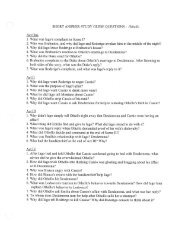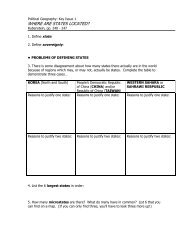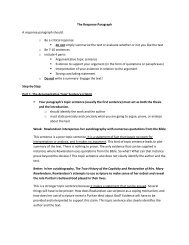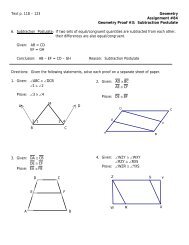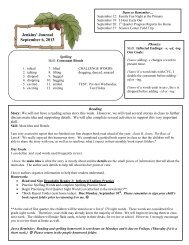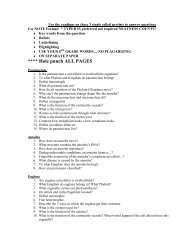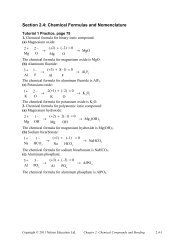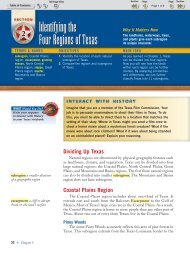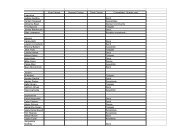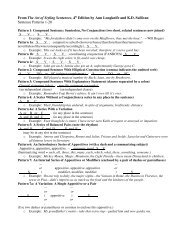File chapter 12 section 3 hei.pdf - Teacher
File chapter 12 section 3 hei.pdf - Teacher
File chapter 12 section 3 hei.pdf - Teacher
You also want an ePaper? Increase the reach of your titles
YUMPU automatically turns print PDFs into web optimized ePapers that Google loves.
282-285-Chapter<strong>12</strong> 10/16/02 10:51 AM Page 282<br />
Human–Environment<br />
Interaction<br />
A HUMAN PERSPECTIVE “1800 DIE IN WIND-WHIPPED FLOOD<br />
WATERS!” February 1, 1953, witnessed a disaster in the Netherlands.<br />
Winds estimated at 110 to 115 miles per hour piled up gigantic waves<br />
that ripped through dikes—earthen banks—holding back the North Sea.<br />
When the storm was over, 4.5 percent of the Netherlands was flooded,<br />
and thousands of buildings were destroyed. The Netherlands is prone to<br />
floods because much of its land is below sea level.<br />
Main Ideas<br />
• The Dutch and the Venetians<br />
altered lands to fit t<strong>hei</strong>r<br />
needs by constructing<br />
polders and canals.<br />
• Uncontrolled logging and<br />
acid rain destroy forests.<br />
Places & Terms<br />
dike terpen<br />
polder<br />
seaworks<br />
Zuider Zee<br />
Ijsselmeer<br />
Connect to the Issues<br />
pollution Water pollution<br />
is creating conditions that kill<br />
the fish in Venice’s lagoon.<br />
Polders: Land from the Sea<br />
An old saying declares, “God created the world, but the Dutch created<br />
Holland.” (Holland is another name for the Netherlands.) Because the<br />
Dutch needed more land for t<strong>hei</strong>r growing population, they reclaimed<br />
land from the sea. At least 40 percent of the Netherlands was once under<br />
the sea. Land that is reclaimed by diking and draining is called a polder.<br />
Making a Polder<br />
The water is gradually<br />
pumped away and<br />
drained off the land.<br />
SKILLBUILDER: Interpreting Graphics<br />
HUMAN–ENVIRONMENT INTERACTION Why does it take<br />
time for polder land to be ready for farming?<br />
PLACE How would the process be different if a polder were made<br />
in a place where there is freshwater, not saltwater?<br />
Seawater leaves salt in the soil. Rain<br />
gradually washes the salt away.<br />
Earthen dikes<br />
are built around<br />
a shallow area<br />
of water.<br />
Alfalfa is often the first<br />
crop sown. It has deep<br />
roots, which break up soil;<br />
alfalfa is also used for<br />
livestock feed.<br />
Windmills once supplied the<br />
power used to pump water from<br />
polder land. Today electric pumps<br />
are used to drain the land.<br />
In time, the land can be<br />
used to grow many crops—<br />
such as Dutch tulips.<br />
282
282-285-Chapter<strong>12</strong> 10/16/02 10:51 AM Page 283<br />
Making<br />
Comparisons<br />
What are<br />
possible disadvantages<br />
of<br />
windmills and of<br />
electric pumps?<br />
A. Answer Windmills<br />
wouldn’t<br />
work on still days;<br />
electric pumps<br />
wouldn’t work<br />
during power<br />
outages.<br />
Background<br />
A land link to<br />
Venice was built<br />
in 1846. A railway<br />
bridge connected<br />
Venice to the<br />
mainland.<br />
SEAWORKS The Dutch erected seaworks, structures that are used to<br />
control the sea’s destructive impact on human life. Those seaworks<br />
include dikes and high earthen platforms called terpen. The dikes hold<br />
back the sea, while the terpen provide places to go for safety during<br />
floods and high tides.<br />
Over the centuries, the Dutch found ways to reinforce the dikes and<br />
to control water in the low-lying areas the dikes protected. In the 1400s,<br />
the Dutch began using t<strong>hei</strong>r windmills to power pumps that drained<br />
the land. When the French conqueror Napoleon viewed a site with 860<br />
windmills pumping an area dry, he reportedly said, “Without equal.”<br />
Today the pumps use electric motors instead of windmills.<br />
TRANSFORMING THE SEA Another remarkable Dutch alteration of<br />
t<strong>hei</strong>r environment was the transformation of the Zuider Zee<br />
(ZEYE•duhr ZAY). It was an arm of the North Sea and is now a freshwater<br />
lake. The idea was originally proposed in 1667. But it was not<br />
until the late 1800s and early 1900s that the Dutch perfected a plan to<br />
build dikes all the way across the entrance to the Zuider Zee. Since no<br />
saltwater flowed into that body of water, it eventually became a freshwater<br />
lake. It is now called Ijsselmeer (EYE•suhl•MAIR). The land around<br />
the lake was drained, creating several polders that added hundreds of<br />
square miles of land to the Netherlands.<br />
Waterways for Commerce: Venice’s Canals<br />
Like the Netherlands, Venice, Italy, is a place where humans created a<br />
unique environment. About <strong>12</strong>0 islands and part of the mainland make<br />
up the city of Venice. Two of the largest islands are San Marco and<br />
Rialto. A broad waterway called the Grand Canal flows between them.<br />
Moving people or goods in Venice depends upon using the more than<br />
150 canals that snake around and through the islands. Consequently, to<br />
get from one place to another in Venice, you generally have two choices:<br />
take a boat or walk. Almost anything that is moved on wheels elsewhere<br />
is moved by water in Venice.<br />
AN ISLAND CITY GROWS Venice began when people escaping<br />
invaders took shelter on inhospitable islands in a lagoon. They<br />
remained there and established a settlement that eventually became<br />
Venice. The city is located at the north end of the Adriatic Sea, a good<br />
site for a port. As a result, trade helped Venice grow.<br />
BUILDING ON THE ISLANDS Building Venice required construction<br />
techniques that took into account the swampy land on the islands.<br />
Builders sunk wooden pilings into the ground to help support the structures<br />
above. So many pilings were required that oak forests in the<br />
northern Italian countryside and in Slovenia were leveled to supply the<br />
wood. The weight of the buildings is so great that it has compressed the<br />
underlying ground. This is one of the reasons that Venice is gradually<br />
sinking. Other reasons include rising sea levels and the removal of too<br />
much groundwater by pumping.<br />
PROBLEMS TODAY Severe water pollution threatens historic Venice.<br />
Industrial waste, sewage, and saltwater are combining to eat away the<br />
EUROPE<br />
Human–Environment Interaction 283
282-285-Chapter<strong>12</strong> 10/16/02 10:51 AM Page 284<br />
Canals of Venice<br />
Venice<br />
Lagoon of Venice<br />
San<br />
Michele<br />
W<br />
N<br />
E<br />
S<br />
Grand Canal<br />
Sacca Fisola<br />
Giudecca Canal<br />
0<br />
.4 .8 miles<br />
0 .4 .8 kilometers<br />
Transverse Mercator Projection<br />
La Giudecca<br />
St. Mark's Canal<br />
La Grazia<br />
San Giorgio<br />
Maggiore<br />
SKILLBUILDER: Interpreting Maps<br />
Street<br />
MOVEMENT What is the advantage of having<br />
both streets and canals in Venice?<br />
HUMAN-ENVIRONMENT INTERACTION How<br />
have humans altered the environment of the islands<br />
of Venice?<br />
MOVEMENT Waterbuses,<br />
motorboat taxis, small river boats,<br />
and gondolas move people and<br />
goods on the canals of Venice.<br />
Gondolas generally are too<br />
expensive for local people to hire.<br />
Instead, tourists use them for<br />
sightseeing.<br />
foundations of buildings and damage the buildings themselves. Erosion<br />
has allowed increased amounts of seawater into the lagoon. Because of<br />
this, floods also endanger the city. In November 1966, six feet of floodwater<br />
engulfed the city and ruined many of its buildings and the artwork<br />
that they housed. Agricultural runoff flowing into Venice’s harbor<br />
creates conditions that promote algae growth, sometimes called “killer<br />
algae.” These algae grow rapidly and, after they die, decay. The decaying<br />
process uses up oxygen in the water, so that fish also die. Dead fish<br />
attract insects and create a stench, especially in warm weather.<br />
A Centuries-Old Problem: Deforestation<br />
Throughout history, humans have damaged and destroyed Europe’s<br />
forests. The term deforestation means the clearing of forests from an<br />
area. Often when we think of deforestation, we think of losing the great<br />
rain forests of the world, such as those in South America, which you<br />
learned about in Unit 3. But people have also been clearing the forests<br />
of Europe since ancient times. Forests provided wood to burn for fuel<br />
and to use as building material for ships and houses. When Europeans<br />
began to develop industry in the 1700s and 1800s, they needed even<br />
284 CHAPTER <strong>12</strong>
282-285-Chapter<strong>12</strong> 10/16/02 10:51 AM Page 285<br />
more wood to make charcoal for blast furnaces. Eventually, they used<br />
coal as a fuel in place of wood, but not before huge areas of Europe had<br />
lost t<strong>hei</strong>r native forests.<br />
HUMAN–<br />
ENVIRONMENT<br />
INTERACTION A<br />
forest in Bohemia in<br />
the Czech Republic is<br />
dying from the effects<br />
of acid rain.<br />
Why would restoring<br />
the forest be a slow<br />
process?<br />
B. Answer Such<br />
a union might<br />
foster cooperation<br />
among member<br />
nations in the<br />
clean-up effort.<br />
Connect to<br />
the Issues<br />
unification<br />
How might a<br />
union of nations<br />
affect the clean-up<br />
effort?<br />
ACID RAIN STRIPS FORESTS In the 1960s, people noticed that many<br />
trees of the Black Forest in Germany were discolored, losing needles<br />
and leaves, and dying. In time, scientists identified one cause of the tree<br />
deaths as acid rain. Europe’s factories produce high amounts of sulfur<br />
dioxide and nitrogen oxide emissions. These combine with water vapor<br />
and oxygen to form acid rain or snow. Winds carry the emissions to<br />
other parts of Europe, affecting an estimated one-fourth of all European<br />
forests. This problem has hit Scandinavia particularly hard, since the<br />
prevailing winds blow in that direction. As mentioned earlier, the Black<br />
Forest in Germany also has suffered extreme damage. To save the<br />
remaining forests, nations must work together to reduce air pollution.<br />
You can read more about this in Chapter 14.<br />
As you will read in Chapter 13, the ways people live upon the land<br />
and interact with each other make up the human geography of Europe.<br />
EUROPE<br />
Places & Terms<br />
Taking Notes<br />
Main Ideas<br />
Geographic Thinking<br />
Identify and explain<br />
where in the region<br />
these would be found.<br />
• dike<br />
• polder<br />
• seaworks<br />
• terpen<br />
• Zuider Zee<br />
• Ijsselmeer<br />
HUMAN-ENVIRONMENT<br />
INTERACTION Review your notes<br />
for this <strong>section</strong>.<br />
Human-Environment<br />
Interaction<br />
• What are examples of human<br />
adaptation to the environment?<br />
• What are examples of an<br />
environment changed by humans?<br />
a. How have the people of<br />
the Netherlands been able<br />
to create more land for<br />
t<strong>hei</strong>r country?<br />
b. How has pollution affected<br />
the city of Venice?<br />
c. How has industrialization<br />
hurt the forests of<br />
Europe?<br />
Making Comparisons<br />
What is similar about the<br />
ways that the people of the<br />
Netherlands and the people<br />
of Venice interact with t<strong>hei</strong>r<br />
environments? Think about:<br />
• seaworks in the Netherlands<br />
• canals in Venice<br />
See Skillbuilder<br />
Handbook, page R3.<br />
SEEING PATTERNS Pollution has affected both Venice and the forests of Scandinavia. Create<br />
two cause-and-effect charts outlining the causes and effects of pollution in each place.<br />
Then write a sentence or two summarizing the similarities.<br />
Human–Environment Interaction 285



